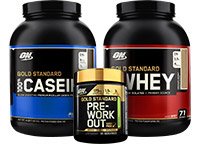
10 Ways To Stay Lean Year-Round
Getting in great shape is half the battle; the other half is staying that way. Ditch the on-season/offseason mentality and learn how to stay ripped year-round!
Every competitive physique athlete who steps onstage, every before-and-after transformation success story, and every individual who has finally reached their fat-loss goals shares one thing in common: a long, challenging, and arduous road to get in the best shape of their life.
Those who reach their goals deserve a hearty congratulations for achieving something they had probably never thought possible! But such an accomplishment does leave one question on the table: Where do you go from there?
Not so long ago, when bodybuilding was the only physique contest around, competitors spent 12-16 weeks getting in super-ripped shape for a contest, only to regain 30-40 pounds back a few days after the show. That body weight yo-yo led to what we now call "offseason condition" versus "contest shape." For most elite bodybuilders, the number of weeks they spent in their best shape could be measured on a single hand.
Today's physique athletes are no less interested in reaching peak condition come contest time, but they have no interest in displaying any sort of offseason physique, looking soft, or otherwise lacking clear muscle definition. This year-round level of lean undoubtedly requires a different kind of approach than simply trying to peak for a one-time event—and that's where I can help.

Living Lean 365
Staying lean—and we're talking single-digit body-fat percent—is incredibly challenging, and it may even be unrealistic for some people. But it's not impossible. Of course, you can't simply work hard as hell and then coast once you reach your goal, since your body will be inclined to go back to its natural equilibrium.
For those of you who are determined to not only get in great shape, but stay there, I've compiled 10 essential tips on how to remain lean year-round. Incorporate as many as possible to ensure you look photo-shoot ready whenever you have a chance to peel off your shirt. (And I assume you'll look for every opportunity to do so!)
Stop "dieting."
To stay lean 365, you can't follow a short-term diet that simply restricts calories. You need to develop a lifestyle buoyed by positive habits that will be the true keys to maintaining the body you've worked so hard for.
To succeed, you can't "diet." You need to cultivate a balanced, fitness-oriented lifestyle that you pursue with a passion, not just because you "have to." Balanced, in this case, simply means not putting all your eggs in one basket: You don't have to live as if fitness is the only worthwhile pursuit in your life, but if you want to be lean all year, it should be something you love.
You obviously followed a restrictive diet to get lean, but the one you follow from here should ease up on the calorie reduction—you simply can't keep following a calorically-negative diet indefinitely. You can still cycle carbs, if you prefer, but ease up on the low days.
Clean, unprocessed foods are still your best choices, and you still want to keep your eye on how they're prepared. Sauces, oils, and desserts should remain on your "avoid most of the time" list, or you'll undo your hard work in a hurry.
You have to learn to love the tenets of fit living without a looming deadline. If you can find healthy substitutions for your favorite treats and embrace the good habits that got you into the best shape of your life, you'll be primed for success.
Count your macros
Success in the kitchen doesn't happen by accident. Keeping tabs on your macros (protein, carbs, and fat) and calories probably helped you get in shape, and it's definitely key to helping you stay there. Don't overlook the value of nutrition tracking, which allows you to stay on top of your daily total caloric count, even after you hit your goal.
Competitors typically measure all their foods, and for good reason. Hopefully during that process you learned to eyeball how much a quarter cup is, or an 8-ounce portion of steak. Whether you eyeball or weigh, at least approximating your diet on an app like MyFitnessPal can help you keep better track of your daily numbers and macro counts.
Remember that overeating by just 200 calories a day might not do much damage in the short term, but can cause weight gain over time if done consistently.
Emphasize carbs pre- and post-workout
If you want to keep visible abs on a daily basis, you're going to have to monitor your carbohydrate intake. You can't just go carb-splurging at every meal if you want to retain definition. With that in mind, the majority of your carbs should be used for energy and recovery just before and after training sessions. The remainder of your carbs should be distributed in smaller amounts throughout your day.
Consume faster-acting simple carbohydrates (along with protein) right after your training. Complex carbs like those found in whole grains, brown rice, yams, sweet potatoes, and quinoa digest more slowly and don't spike your insulin as dramatically, making them better choices throughout the day.
Choose supplements that match your needs
The supplement stack you used to get into great shape isn't necessarily the same one you'd use to add strength and size, so your long-term goal really dictates what you should be taking. Assuming you want to stay lean and slowly gain muscle over time, consider whey protein, creatine, and caffeine as your starting point. Those supplements have been shown to support muscle growth, fight fatigue, help you burn more body fat, and increase mental drive.
Allow yourself the occasional cheat meal
By now, you've learned that cravings arise during periods of food deprivation. Rather than blowing all your hard-earned gains during a cheat weekend, allow yourself an occasional cheat meal as a reward for eating right—perhaps once a week, depending on your metabolism. Cheat meals aren't about chowing down as much junk as you can; they should be a moderate indulgence that allows you to get back on track without any spillover urges for the wrong kinds of foods. Remember, cheat meals are a reward you have to earn!
Compound your workouts
Compound or multijoint movements, in which more than a single pair of joints are at work, engage more muscle mass than isolation exercises. (A bench press engages more muscle than a fly, for example.) Compound movements elicit a greater hormonal and energy response than isolation lifts, which helps you build more muscle and burn a greater number of calories. With this in mind, make sure your training is built around squats, deadlifts, bench presses, rows, and overhead presses rather than biceps curls, leg extensions, and flyes.
Burn more calories with HIIT
If ever there was a "secret" to getting more out of your cardio training, this is it. High-intensity interval training (HIIT) simply means alternating all-out work intervals with slower recovery periods, which has been shown to not only elevate the number of calories you burn during your workout, but boost your metabolism during the 24 hours afterward. HIIT also takes less time than traditional steady-state cardio.
After your cardio warm-up, perform a HIIT session by completing all-out effort for 30 seconds, followed by 60 seconds of low-intensity effort, for anywhere from 15-30 minutes. As you get better, lengthen the work interval, reduce the recovery interval, increase the degree of effort, and/or lengthen the duration of your workout.
HIIT can be done outdoors with running or indoors on the treadmill, elliptical training, or stair-stepper. It should be done 2-3 times per week.
Switch up the way you train
Do the same movements with the same load for the same sets and reps, and you can bet your body will quickly adapt to that stimulus. As the body adapts, you need to alter your training stimulus to make continual gains. Learn how to manipulate load, volume, intensity, rest periods, and training to failure so your body doesn't grow accustomed to a specific routine. This reduces the likelihood of overtraining, provides a fresh mental approach.
One of my favorite methods of making change is to switch around my training goals so that my body constantly has to adapt to something new. One week I focus on strength training, the next hypertrophy, and the following might be performance-based.
Be realistic about your body fat
While remaining ripped long after you bring your body fat down is your goal, the point at which you ultimately settle has to be both realistic and healthy. If you're killing yourself 24/7 to stay at a ludicrously low body-fat level, you should readjust your goal.
How lean should you get? You have to find a point at which you enjoy your training, can realistically follow an eating plan, and live a balanced life. That's where you'll ultimately settle. That may be 6 percent body fat for some, 10 percent for others. Don't get hung up on the numbers—find the combination of elements that works best for you.
Again, if you're not embracing the lifestyle, you ultimately won't be successful at it.
Make smart choices that lead to lasting habits
Every item above relates to a choice you consciously have to make on a daily basis. The foods you put on your plate, the exercises you do in the gym, the supplements you take, and the kind of fitness lifestyle you choose to follow are all based on choices. Make smart, healthy choices over time, and you'll eventually no longer have to choose. By that point, you will have built powerful, positive, and automatic habits! That's when you'll learn to stay lean year-round.
The views expressed in this article are those of the author and do not reflect the opinions of Glanbia Performance Nutrition, Inc.



